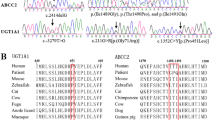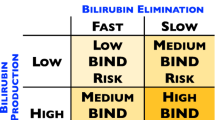Abstract
Glucose-6-phosphate dehydrogenase (G-6-PD) deficiency is a common condition with a worldwide distribution that has the potential for causing severe hyperbilirubinemia with bilirubin encephalopathy. Hemolysis resulting from identifiable triggers may be the cause of the jaundice in some cases, but in many, jaundice continues to occur despite avoidance of contact with known hemolytic triggers. In some G-6-PD–deficient population groups, carboxyhemoglobin studies have indicated exaggerated hemolysis; but in others, increased hemolysis has not correlated with serum total bilirubin values.
As hyperbilirubinemia results from an imbalance between bilirubin production and bilirubin elimination, diminished bilirubin conjugation was suspected to contribute to the pathogenesis of hyperbilirubinemia. Serum-conjugated bilirubin fractions, reflecting intrahepatocytic bilirubin conjugation, were low in G-6-PD–deficient neonates who developed hyperbilirubinemia. This conjugated bilirubin profile was similar to that seen in adults with Gilbert's Syndrome, a condition associated with promoter polymorphism for the gene encoding the bilirubin-conjugating enzyme, UGT glucuronosyltransferase 1A1 (UGT). Whereas G-6-PD deficiency or Gilbert's Syndrome, alone, did not predispose to hyperbilirubinemia, G-6-PD–deficient neonates who also were heterozygotes or homozygotes for the variant UGT gene promoter did have significantly increased incidences of hyperbilirubinemia. Additional conditions which predispose to neonatal jaundice in the presence of Gilbert's Syndrome, include Coombs' negative ABO blood group heterospecificity, hereditary spherocytosis, and prolonged breastfeeding.
Gilbert's Syndrome and G-6-PD deficiency are both common, inherited conditions. Individually, and in the absence of additional genetic or environmental factors, both are benign, and should result in minimal health disturbance or interference with the quality of life of affected individuals. However, in combination, or following exposure to environmental or other genetic factors, these benign conditions may have severe manifestations, with potentially dangerous and possibly life-threatening consequences. This review highlights the major clinical features of both Gilbert's Syndrome and G-6-PD deficiency, and surveys a series of studies related to neonatal jaundice in G-6-PD–deficient neonates culminating in the documentation of an interaction between the two conditions that is crucial to the pathogenesis of hyperbilirubinemia.
This is a preview of subscription content, access via your institution
Access options
Subscribe to this journal
Receive 12 print issues and online access
$259.00 per year
only $21.58 per issue
Buy this article
- Purchase on SpringerLink
- Instant access to full article PDF
Prices may be subject to local taxes which are calculated during checkout
Similar content being viewed by others
References
Burchell B, Hume R Molecular genetic basis of Gilbert's Syndrome J Gastroenterol Hepatol 1999 14 960–6
Muraca M, Fevery J, Blanckaert N Relationships between serum bilirubins and production and conjugation of bilirubin. Studies in Gilbert's Syndrome, Crigler–Najjar disease, hemolytic disorders and rat models Gastroenterology 1987 92 309–17
Bosma PJ, Chowdhury JR, Bakker C, et al The genetic basis of the reduced expression of bilirubin UDP-glucuronosyltransferase 1 in Gilbert's Syndrome N Engl J Med 1995 333 1171–5
Monaghan G, Ryan M, Seddon R, Hume R, Burchell B Genetic variation in bilirubin UDP-glucuronosyltransferase gene promoter and Gilbert's syndrome Lancet 1996 347 578–81
Raijmakers MTM, Jansen PLM, Steegers EAP, Peters WHM Association of human liver bilirubin UDP-glucuronosyltransferase activity with a polymorphism in the promoter region of the UGT1A1 gene J Hepatol 2000 33 348–51
Maruo Y, Nishizawa K, Sato H, Doida Y, Shimada M Association of neonatal hyperbilirubinemia with bilirubin UDP-glucuronosyltransferase polymorphism Pediatrics 1999 103 1224–7
Beutler E G6PD deficiency Blood 1994 84 3613–36
Kaplan M, Hammerman C Severe neonatal hyperbilirubinemia. A potential complication of glucose-6-phosphate dehydrogenase deficiency Clin Perinatol 1998 25 575–90
Valaes T Severe neonatal jaundice associated with glucose-6-phosphate dehydrogenase deficiency: pathogenesis and global epidemiology Acta Paediatr Suppl 1994 394 58–76
Johnson L, Brown AK A pilot registry for acute and chronic kernicterus in term and near term infants Pediatrics 1999 104 (suppl) 736A
Kaplan M, Hammerman C, Vreman HJ, Stevenson DK, Beutler E Acute hemolysis and severe neonatal hyperbilirubinemia in glucose-6-phosphate dehydrogenase–deficient heterozygotes J Pediatr 2001 139 137–40
Kaplan M, Abramov A Neonatal hyperbilirubinemia associated with glucose-6-phosphate dehydrogenase deficiency in Sephardic–Jewish infants: incidence, severity and the effect of phototherapy Pediatrics 1992 90 401–95
Slusher TM, Vreman HJ, McLaren DW, Lewison LJ, Brown AK, Stevenson DK Glucose-6-phosphate dehydrogenase deficiency and carboxyhemoglobin concentrations associated with bilirubin-related morbidity and death in Nigerian infants J Pediatr 1995 126 102–8
Meloni T, Cutillo S, Testa U, Luzatto L Neonatal jaundice and severity of glucose-6-phosphate dehydrogenase deficiency in Sardinian babies Early Hum Dev 1987 15 317–22
Kaplan M, Vreman HJ, Hammerman C, Leiter C, Abramov A, Stevenson DK Contribution of haemolysis to jaundice in Sephardic Jewish glucose-6-phosphate dehydrogenase–deficient neonates Br J Haematol 1996 93 822–7
Valaes T, Karaklis A, Stravrakakis D, Bavela-Stravrakakis K, Perakis A, Doxiadis SA Incidence and mechanism of neonatal jaundice related to glucose-6-phosphate dehydrogenase deficiency Pediatr Res 1969 3 448–58
Stevenson DK, Vreman HJ Carbon monoxide and bilirubin production in neonates Pediatrics 1997 100 252–4
Necheles TF, Rai US, Valaes T The role of hemolysis in neonatal hyperbilirubinemia as reflected in carboxyhemoglobin levels Acta Paediatr Scand 1976 65 361–7
Kaplan M, Rubaltelli FF, Hammerman C, et al Conjugated bilirubin in neonates with glucose-6-phosphate dehydrogenase deficiency J Pediatr 1996 128 695–7
Kaplan M, Muraca M, Hammerman C, et al Bilirubin conjugation, reflected by conjugated bilirubin fractions, in glucose-6-phosphate dehydrogenase–deficient neonates: a determining factor in the pathogenesis of hyperbilirubinemia Pediatrics 1998 102 (3) 1–6 Available at http://www.pediatrics.org/cgi/content/full/102/3/e37
Bancroft JD, Kreamer B, Gourley GR Gilbert Syndrome accelerates the development of neonatal jaundice J Pediatr 1998 132 656–60
Kaplan M, Renbaum P, Levi-Lahad E, Hammerman C, Lahad A, Beutler E Gilbert Syndrome and glucose-6-phosphate dehydrogenase deficiency: a dose-dependent genetic interaction crucial to neonatal hyperbilirubinemia Proc Natl Acad Sci USA 1997 94 12128–32
Iolascon A, Faienza MF, Moretti A, Perotta S, Miraglia del Giudice E UGT1 promoter polymorphism accounts for increased neonatal appearance of hereditary spherocytosis Blood 1998 91 1093
Kaplan M, Hammerman C, Renbaum P, Klein G, Levy-Lahad E Gilbert's syndrome and hyperbilirubinemia in ABO-incompatible neonates Lancet 2000 356 652–3
Monaghan G, McLellan A, McGeehan A, et al Gilbert's syndrome is a contributory factor in prolonged unconjugated hyperbilirubinemia of the newborn J Pediatr 1999 134 441–6
Author information
Authors and Affiliations
Rights and permissions
About this article
Cite this article
Kaplan, M. Genetic Interactions in the Pathogenesis of Neonatal Hyperbilirubinemia: Gilbert's Syndrome and Glucose-6-Phosphate Dehydrogenase Deficiency. J Perinatol 21 (Suppl 1), S30–S34 (2001). https://doi.org/10.1038/sj.jp.7210630
Published:
Issue date:
DOI: https://doi.org/10.1038/sj.jp.7210630
This article is cited by
-
Glucose-6-phosphate dehydrogenase deficiency in triplets of African-American descent
Journal of Perinatology (2006)
-
Pharmacogenomics of human UDP-glucuronosyltransferase enzymes
The Pharmacogenomics Journal (2003)



